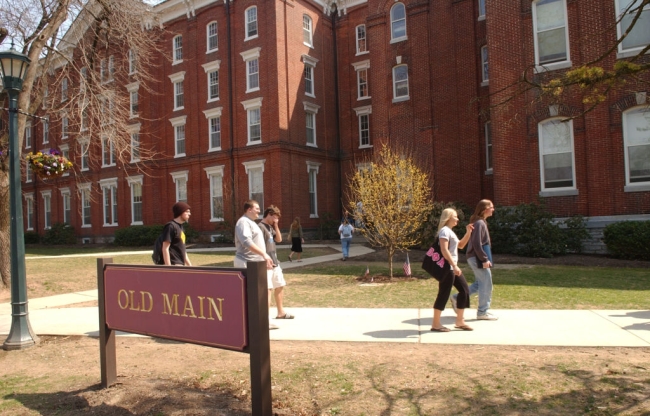You have /5 articles left.
Sign up for a free account or log in.

Students walk on the Kutztown University campus. This fall, the university saw a 2.8 percent enrollment decline.
MediaNews Group/Reading Eagle via Getty Images/Contributor/Getty Images
The post-pandemic enrollment rebound everyone wished for has not come to pass.
College and university enrollments are still on the decline for most institutions, early data from the National Student Clearinghouse Research Center show. Undergraduate enrollment across the board fell by 3.2 percent this fall, echoing last fall’s 3.4 percent decline. Since fall 2019, undergraduate enrollments have dropped by 6.5 percent.
The top-line findings paint a bleak picture for higher education’s recovery.
“We’ve really not seen declines across the board like this,” said Doug Shapiro, vice president of research and executive director of the research center.
Students still have not returned to college at the rate they left, and it will likely take years of work to bring them back into the fold, Shapiro fears.
“A lot of those freshmen who didn’t show up last year -- they haven’t come back yet,” Shapiro said. “The longer students are away from school, the harder and harder it becomes for them to come back. It may well be that a majority of them might not ever make it back, and that’s very much a concern.”
A closer look at the data shows a more varied picture. Wealthy and prestigious institutions -- public and private -- have nearly recovered whatever enrollments they lost last fall. Graduate enrollments continue to climb. Declines at public two-year institutions -- which have borne the brunt of pandemic-era enrollment losses -- are starting to ease up.
In fact, selective institutions saw enrollment gains this fall. Highly selective private, nonprofit institutions saw an 11.7 percent increase in freshman enrollments this fall, compared with an 8.7 percent decline last fall. Over all, such institutions have netted a 2 percent freshman enrollment increase since fall 2019.
Likewise, highly selective public institutions saw a freshman enrollment increase of 1.2 percent this fall, compared with a 5.6 percent decline last fall. Some public institutions are seeing record enrollments despite the pandemic. The University of Utah, for example, announced Monday that its fall enrollment of 34,424 shattered previous records. The University of Wisconsin at Madison also welcomed its largest-ever freshman class this fall, enrolling 8,465 first-year students.
As the pandemic wanes, elite private colleges are faring especially well. Not only have these colleges retained and attracted students amid the pandemic, but they’ve also seen explosive growth in their investments. Most colleges have not been so lucky.
Public two-year institutions saw a 5.6 percent decline in enrollments this fall, compared with a 9 percent drop last fall, clearinghouse data show. That means the sector has netted a 14.1 percent enrollment decline since 2019. While community colleges have been hit hard by the pandemic, they’re also working diligently to bring students back. Many two-year institutions dialed up their outreach efforts over the summer and into early fall to enroll more students.
Enrollment statistics don’t always paint a clear picture of what’s happening on the ground, said Cecilia Orphan, assistant professor of higher education at the University of Denver and co-director of the Alliance for Research on Regional Colleges. For example, the data on freshman enrollment leaves out the many students who work and transfer into a regional public four-year college.
“These students are more likely to be working full-time or part-time while going to college, and we have a labor market that’s rebounding,” Orphan said. “So those people are able to find jobs more easily, and so they’re pulling back on the number of credits that they’re taking.”
Orphan also noted that declines among some public institutions may not be due strictly to the pandemic, so it’s unlikely they would reverse now. Many public institutions are chronically underfunded and unable to serve as many students as they would like.
“Often what we’re seeing is that those [declines] are just continuations of regional and statewide trends and demographic shifts, rather than anything sudden that happened through the pandemic,” Orphan said.
Black students and white students saw the largest undergraduate enrollment declines this fall, with their numbers dropping by 5.1 percent and 4.8 percent, respectively. Latinx undergraduate enrollment fell by 2.4 percent this fall, compared with 2.8 percent last year. Asian undergraduate enrollment dropped by 2.2 percent this fall, compared with 3.5 percent last year. The enrollment of Native American undergraduates declined by 4.4 percent this semester, compared with 8.8 percent last fall.
Enrollment also varied by age. The number of dually enrolled high school students bumped up by 0.7 percent this fall, while enrollment of students between 18 and 20 declined by 2.6 percent, 21- to 24-year-old student enrollment fell by 3.1 percent, and enrollment of students older than 29 fell by 3.3 percent this fall. Students aged 25 to 29 saw the largest enrollment dip this fall, dropping by 8.3 percent.
Meanwhile, graduate enrollments increased by 2.1 percent across the board this fall. The number of international graduate students has quickly rebounded, rising by 13.1 percent this fall after a drop of 7.8 percent last fall.
Half of the institutions that participate in the clearinghouse supplied data as of Sept. 23, in time for this report. In total, those data capture 8.4 million students. The for-profit sector has had the lowest response rate so far, with only 39.4 percent reporting, while 53.6 percent of public four-year colleges, 49.5 percent of private four-year colleges and 46.6 percent of public two-year colleges reporting enrollment data.
Shapiro doesn’t expect the numbers to change much when the remaining institutions share their enrollments.
“We didn’t see much of a difference in the overall picture when we went from the early report last fall to the next report a month later,” Shapiro said. But there could be some subgroups that see small shifts, particularly among the for-profit sector.








